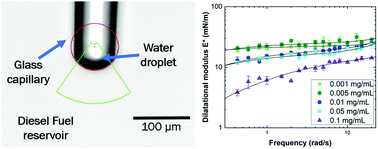Dilatational rheology of water-in-diesel fuel interfaces: effect of surfactant concentration and bulk-to-interface exchange
Abstract
Micrometer-sized water droplets dispersed in diesel fuel are stabilized by the fuel's surface-active additives, such as mono-olein and poly(isobutylene)succinimide (PIBSI), making the droplets challenging for coalescing filters to separate. Dynamic material properties found from interfacial rheology are known to influence the behavior of microscale droplets in coalescing filters. In this work, we study the interfacial dilatational properties of water-in-fuel interfaces laden with mono-olein and PIBSI, with a fuel phase of clay-treated ultra-low sulphur diesel (CT ULSD). First, the dynamic interfacial tension (IFT) is measured using pendant drop tensiometry, and a curvature-dependent form of the Ward and Tordai diffusion equation is applied for extracting the diffusivity of the surfactants. Additionally, Langmuir kinetics are applied to the dynamic IFT results to obtain the maximum surface concentration (Γ∞) and ratio of adsorption to desorption rate constants (κ). We then use a capillary pressure microtensiometer to measure the interfacial dilatational modulus, and further extract the characteristic frequency of surfactant exchange (ω0) by fitting a model assuming diffusive exchange between the interface and bulk. In this measurement, 50–100 μm diameter water droplets are pinned at the tip of a glass capillary in contact with the surfactant-containing fuel phase, and small amplitude capillary pressure oscillations over a range of frequencies from 0.45–20 rad s−1 are applied to the interface, inducing changes in interfacial tension and area to yield the dilatational modulus, E*(ω). Over the range of concentrations studied, the dilatational modulus of CT ULSD with either mono-olein or PIBSI increases with a decrease in bulk concentration and plateaus at the lowest concentrations of mono-olein. Characteristic frequency (ω0) values extracted from the fit are compared with those calculated using equilibrium surfactant parameters (κ and Γ∞) derived from pendant drop tensiometry, and good agreement is found between these values. Importantly, the results imply that diffusive exchange models based on the equilibrium relationships between surfactant concentration and interfacial tension can be used to infer the dynamic dilatational behavior of complex surfactant systems, such as the water-in-diesel fuel interfaces in this study.



 Please wait while we load your content...
Please wait while we load your content...